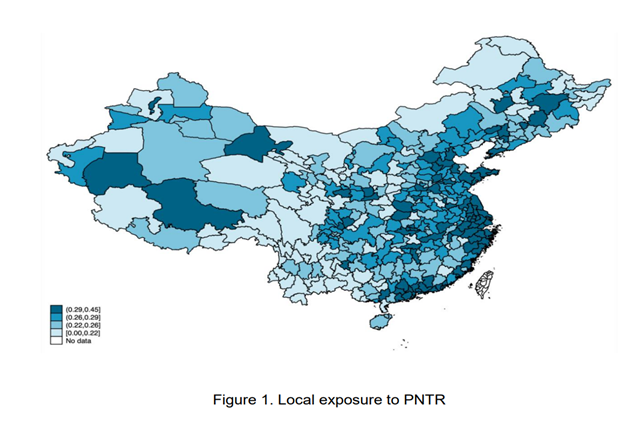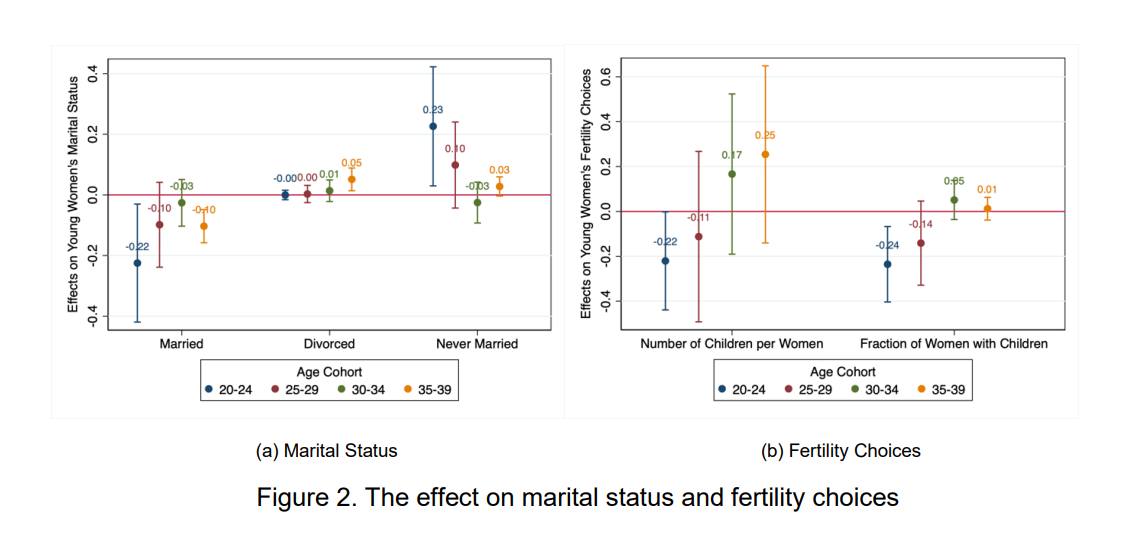Empowered Young Women: Trade Liberalization and Women’s Family Decisions in China
How do women’s marriage and fertility decisions respond to trade liberalization? This column finds that Chinese prefectures more exposed to the US granting of permanent normal trade relations to China have experienced a relative increase in the fraction of unmarried young women and young women without children. The increased employment opportunities from trade liberalization increased Chinese women’s labor participation and allocated more of them to service sectors—where wages are higher—relative to men.

China experienced
a remarkable decline in the marriage rate among young adults in the first
decade of the 21st century. From 2000 to 2010, the percentage of unmarried young
women almost doubled, from 15.72% to 27.09%. During the same period, the percentage
of young women without children also increased significantly, from 20.63% to
33.00%.
What contributed to these shifts in young Chinese women’s marriage and fertility decisions? In a recent study, we examine the potential role of international trade (Ouyang, Yuan, and Zi 2022). We find that the US granting China permanent normal trade relations (PNTR) upon China’s accession to the World Trade Organization (WTO) in 2001 had a statistically and economically meaningful effect on young Chinese women’s delaying marriage and childbearing decisions. While Autor, Dorn, and Hanson (2019), among others, find that import competition from China led to lower marriage and fertility rates in the US by depriving young adult males of employment and income opportunities, we find that the same trade shock also reduced marriage and fertility rates in China, but for a completely different reason: employment adjustments due to the increased export opportunities bolstered the economic power of young Chinese women relative to men, causing them to delay or reduce marriage and childbearing. The existing literature often finds that “the China shock” leads to opposite adjustments in the US and China at various margins, such as manufacturing employment or migration. However, our findings suggest that trade shocks simultaneously improve the economic standing of women relative to men in both countries, which leads to lower marriage and fertility rates in both the US and China.
Local Exposure to PNTR
Our measure of
trade shocks, known as PNTR exposure, is based on two sets of tariff rates in
the US tariff schedule. The first set is referred to as the NTR tariff and
applies to imports from the WTO members. The second set, known as the non-NTR
tariff, is established by the Smoot-Hawley Tariff Act of 1930 and is typically greater
than the corresponding NTR rate. Prior to 2001, China was granted temporary
access to the NTR rate, subject to annual congressional approval. The country’s
accession to the WTO removed this trade policy uncertainty and stimulated
Chinese exports to the US (Handley and Limão 2017).
Following Pierce and Schott (2016), we measure an industry’s trade uncertainty as the gap between the non-NTR and NTR rates. We then translate the trade uncertainties at the industry level into a regional level measure exploiting the initial differences in industrial employment mix across the Chinese prefectures. As illustrated in Figure 1, China’s coastal regions are among the biggest beneficiaries of trade policy changes, but there are also a reasonable number of prefectures in the middle and western regions with large PNTR exposures.

Marriage and Fertility
We find that more-exposed Chinese prefectures have experienced a greater decline in the percentage of married young women compared to the less-exposed prefectures, conditional on province-specific trends. Between 2000 and 2010, the PNTR shock reduced the share of young married women in China by 4.3 percentage points on average. We find no pre-trends and this result is robust to different data permutations and alternative empirical specifications, and to controlling for various potential confounding factors.
Figure 2(a) shows the effect of trade shocks on the fraction of unmarried young women by reasons and age cohorts. The negative effect on the fraction of never married young women is most prominent for the 20–24 age cohort, and it diminishes as the cohort rises. On the other hand, the same trade shock led to more divorces among women at older ages, both contributing to the increase in the percentage of women who do not marry.
Given the tight link between marriage and fertility decisions, it is unsurprising that we also find that more exposed Chinese prefectures have experienced a greater decline in the fraction of young women with children. However, conditional on having children, PNTR increased the number of children born to women. These two effects work in opposite directions, resulting in a negative, although imprecisely estimated, impact of PNTR on the number of children per woman. Figure 2(b) visualizes the effect by age cohort and shows that the negative effect of PNTR on the number of children per woman is significant only for the 20–24 age cohort.

We find that the above findings are largely driven by young women with agricultural hukou and those with low educational attainment, which respectively account for 73.4% and 79.8% of all young women in the 2000 census.
Understanding the Mechanism
How does PNTR reduce or delay marriage and childbearing among young Chinese women? The empirical evidence appears to be most consistent with the economic status hypothesis: trade liberalization may alter young women’s employment opportunities relative to men’s and thus affect their marriage and fertility decisions. This hypothesis dates back to Becker’s (1973) theory of marriage, which states that an increase in women’s relative economic status reduces the gains from family specialization and thus reduces the prevalence of marriage.
Specifically, we find that PNTR has significantly increased the labor force participation of young women, particularly by reducing the share of young women who are not in the labor force due to family caregiving. Moreover, the PNTR shock has led to relatively more young women working in the service sector, where wages are higher than in the agricultural and manufacturing sectors. The prefectures with more pronounced adjustments happen to be the prefectures where the share of married young women has dropped more. Thus, the PNTR-induced decline in marriage and fertility rates among young Chinese women is likely driven by the expansion of female employment and the associated sectoral redistribution, which has increased the economic status of young Chinese women relative to men thanks to trade liberalization.
Implication
The distributional consequences of globalization have fascinated economists and policymakers for decades. We find that trade liberalization has influenced the marriage and childbearing decisions of young Chinese women, by changing their economic status relative to men. In many countries, gender equality issues are at the center of public debate. The new evidence provided by our research contributes to the understanding of why and how trade policy changes may have unintended consequences regarding gender equality.
References
Autor, David, David Dorn, and Gordon Hanson. 2019. “When Work Disappears: Manufacturing Decline and the Falling Marriage Market Value of Young Men.” American Economic Review: Insights 1 (2): 161–78. https://doi.org/10.1257/aeri.20180010.
Becker, Gary S. 1973. “A Theory of Marriage: Part I.” Journal of Political Economy 81(4): 813–46. https://www.jstor.org/stable/1831130.
Handley, Kyle, and Nuno Limão. 2017. “Policy Uncertainty, Trade, and Welfare: Theory and Evidence for China and the United States.” American Economic Review 107 (9): 2731–83. https://doi.org/10.1257/aer.20141419.
Ouyang, Difei, Weidi Yuan, and Yuan Zi. 2022. “Empowered Young Women: Trade Liberalization and Women’s Family Decisions in China.” CEPR Press Discussion Paper No. 17607. https://cepr.org/publications/dp17607.
Pierce, Justin R., and Peter K. Schott. 2016. “The Surprisingly Swift Decline of US Manufacturing Employment.” American Economic Review 106 (7): 1632–62. https://doi.org/10.1257/aer.20131578.

Latest
Most Popular
- VoxChina Covid-19 Forum (Second Edition): China’s Post-Lockdown Economic Recovery VoxChina, Apr 18, 2020
- China’s Great Housing Boom Kaiji Chen, Yi Wen, Oct 11, 2017
- China’s Joint Venture Policy and the International Transfer of Technology Kun Jiang, Wolfgang Keller, Larry D. Qiu, William Ridley, Feb 06, 2019
- The Dark Side of the Chinese Fiscal Stimulus: Evidence from Local Government Debt Yi Huang, Marco Pagano, Ugo Panizza, Jun 28, 2017
- Wealth Redistribution in the Chinese Stock Market: the Role of Bubbles and Crashes Li An, Jiangze Bian, Dong Lou, Donghui Shi, Jul 01, 2020
- What Is Special about China’s Housing Boom? Edward L. Glaeser, Wei Huang, Yueran Ma, Andrei Shleifer, Jun 20, 2017
- Evaluating Risk across Chinese Housing Markets Yongheng Deng, Joseph Gyourko, Jing Wu, Aug 02, 2017
- Privatization and Productivity in China Yuyu Chen, Mitsuru Igami, Masayuki Sawada, Mo Xiao, Jan 31, 2018
- How did China Move Up the Global Value Chains? Hiau Looi Kee, Heiwai Tang, Aug 30, 2017
- China’s Shadow Banking Sector: Wealth Management Products and Issuing Banks Viral V. Acharya, Jun Qian, Zhishu Yang, Aug 09, 2017




 Facebook
Facebook  Twitter
Twitter  Instagram
Instagram WeChat
WeChat  Email
Email 


